|
Working animal
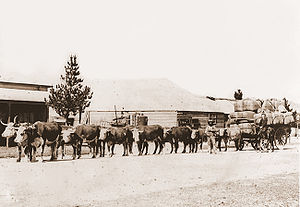 A working animal is an animal, usually domesticated, that is kept by humans and trained to perform tasks instead of being slaughtered to harvest animal products. Some are used for their physical strength (e.g. oxen and draft horses) or for transportation (e.g. riding horses and camels), while others are service animals trained to execute certain specialized tasks (e.g. hunting and guide dogs, messenger pigeons, and fishing cormorants). They may also be used for milking or herding. Some, at the end of their working lives, may also be used for meat or leather. The history of working animals may predate agriculture as dogs were used by hunter-gatherer ancestors; around the world, millions of animals work in relationship with their owners. Domesticated species are often bred for different uses and conditions, especially horses and working dogs. Working animals are usually raised on farms, though some are still captured from the wild, such as dolphins and some Asian elephants.  People have found uses for a wide variety of abilities in animals, and even industrialized societies use many animals for work. People use the strength of horses, elephants, and oxen to pull carts and move loads. Police forces use dogs for finding illegal substances and assisting in apprehending wanted persons, others use dogs to find game or search for missing or trapped people. People use various animals—camels, donkeys, horses, dogs, etc.—for transport, either for riding or to pull wagons and sleds. Other animals, including dogs and monkeys, help disabled people. On rare occasions, wild animals are not only tamed, but trained to perform work—though often solely for novelty or entertainment, as such animals tend to lack the trustworthiness and mild temper of true domesticated working animals. Conversely, not all domesticated animals are working animals. For example, while cats may catch mice, it is an instinctive behavior, not one that can be trained by human intervention. Other domesticated animals, such as sheep or rabbits, may have agricultural uses for meat, hides and wool, but are not suitable for work. Finally, small domestic pets, such as most small birds (other than certain types of pigeon) are generally incapable of performing work other than providing companionship. Roles and specializationsTransportation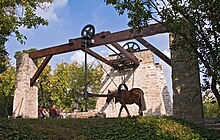 Some animals are used due to sheer physical strength in tasks such as ploughing or logging. Such animals are grouped as a draught or draft animals. Others may be used as pack animals, for animal-powered transport, the movement of people and goods. Together, these are sometimes called beasts of burden. Some animals are ridden by people on their backs and are known as mounts. Alternatively, one or more animals in harness may be used to pull vehicles. Riding animals or mountsRiding animals are animals that people use as mounts in order to perform tasks such as traversing across long distances or over rugged terrain, hunting on horseback or with some other riding animal, patrolling around rural and/or wilderness areas, rounding up and/or herding livestock or even for recreational enjoyment. They mainly include equines such as horses, donkeys, and mules; bovines such as cattle, water buffalo, and yak. In some places, elephants, llamas and camels are also used. Dromedary camels are in arid areas of Australia, North Africa and the Middle East; the less common Bactrian camel inhabits central and East Asia; both are used as working animals. On occasion, reindeer, though usually driven, may be ridden. Certain wild animals have been tamed and used for riding, usually for novelty purposes, including the zebra and the ostrich. Some mythical creatures are believed to act as divine mounts, such as garuda in Hinduism (See vahana for divine mounts in Hinduism) and the winged horse Pegasus in Greek mythology. Pack animals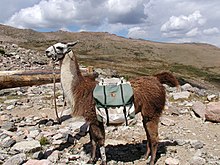 Pack animals may be of the same species as mounts or harness animals, though animals such as horses, mules, donkeys, reindeer and both types of camel may have individual bloodlines or breeds that have been selectively bred for packing. Additional species are only used to carry loads, including llamas in the Andes. Domesticated cattle and yaks are also used as pack animals. Other species used to carry cargo include dogs and pack goats. Draft animals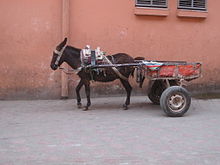  An intermediate use is as draft animals, harnessed singly or in teams, to pull sleds, wheeled vehicles or ploughs.
Assorted wild animals have, on occasion, been tamed and trained to harness, including zebras and even moose. Guard animalsAs some domesticated animals display extremely protective or territorial behavior, certain breeds and species have been utilized to guard people and/or property such as homes, public buildings, businesses, crops, livestock and even venues of criminal activity.[4][5] Guard animals can either act as alarms to alert their owners of danger or they can be used to actively scare off and/or even attack encroaching intruders or dangerous animals. Well known examples of guard animals include dogs, geese and llamas.[citation needed] Powering fixed machinery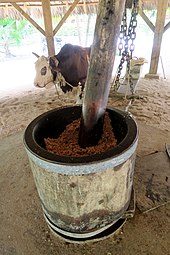 Working draught animals may power fixed machinery using a treadmill and have been used throughout history to power a winch to raise water from a well. Turnspit dogs were formerly used to power roasting jacks for roasting meat. Treatment animalsWorking as a form of biological treatment for the environment. Animals such as Asian carps were imported to the U.S. in 1970s to control algae, weed, and parasite growth in aquatic farms, weeds in canal systems, and as one form of sewage treatment.[6] Pathogens and diseasesAnimals can be used to detect the presence of pathogens and patients carrying infectious diseases.
Searching and retrievingDogs and pigs, with a better sense of smell than humans, can assist with gathering by finding valuable products, such as truffles (a very expensive subterranean fungus). The French typically use truffle hogs, while Italians mainly use dogs.[citation needed] Monkeys are trained to pick coconuts from palm trees, a job many human workers consider as too dangerous.[16] Detecting contrabandDetection dogs, commonly employed by law enforcement authorities, are trained to use their senses to detect illegal drugs, explosives, currency, and contraband electronics such as illicit mobile phones, among other things.[17] The sense most used by detection dogs is smell, hence such dogs are also commonly known as 'sniffer dogs'. For this task, dogs may sometimes be used remotely from the suspect item, for example via the Remote Air Sampling for Canine Olfaction (RASCO) system.[18] Interfacing and organizationAssistance animals
Herding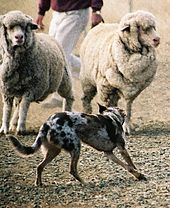
Police and militaryThe defensive and offensive capabilities of animals (such as fangs and claws) can be used to protect or to attack humans.
Legal statusIn some jurisdictions, certain working animals are afforded greater legal rights than other animals. One such common example is police dogs and military dogs, which are often afforded additional protections and the same memorial services as human officers and soldiers. India law have provision for the in loco parentis for implementing animal welfare laws. Under the Indian law the non-human entities such as animals, deities, trusts, charitable organizations, corporate, managing bodies, etc. and several other non-human entitles have been given the status of the "legal person" with legal rights and duties, such as to sue and be sued, to own and transfer the property, to pay taxes, etc. In court cases regarding animals, the animals have the status of "legal person" and humans have the legal duty to act as "loco parentis" towards animals welfare like a parent has towards the minor children. In a case of cow-smuggling, the Punjab and Haryana High Court mandated that "entire animal kingdom including avian and aquatic" species has a "distinct legal persona with corresponding rights, duties, and liabilities of a living person" and humans are "loco parentis" while laying out the norms for animal welfare, veterinary treatment, fodder and shelter, e.g. animal drawn carriages must not have more than four humans, and load carrying animals must not be loaded beyond the specified limits and those limits must be halved when animals have to carry the load up a slope. A court while deciding the Animal Welfare Board of India vs Nagaraja case in 2014 mandated that animals are also entitled to the fundamental right to freedom[20] enshrined in the Article 21 of Constitution of India i.e. right to life, personal liberty and the right to die with dignity (passive euthanasia). In another case, a court in Uttarakhand state mandated that animals have the same rights as humans.[21] See alsoWikimedia Commons has media related to Working animals.
References
External links
|

